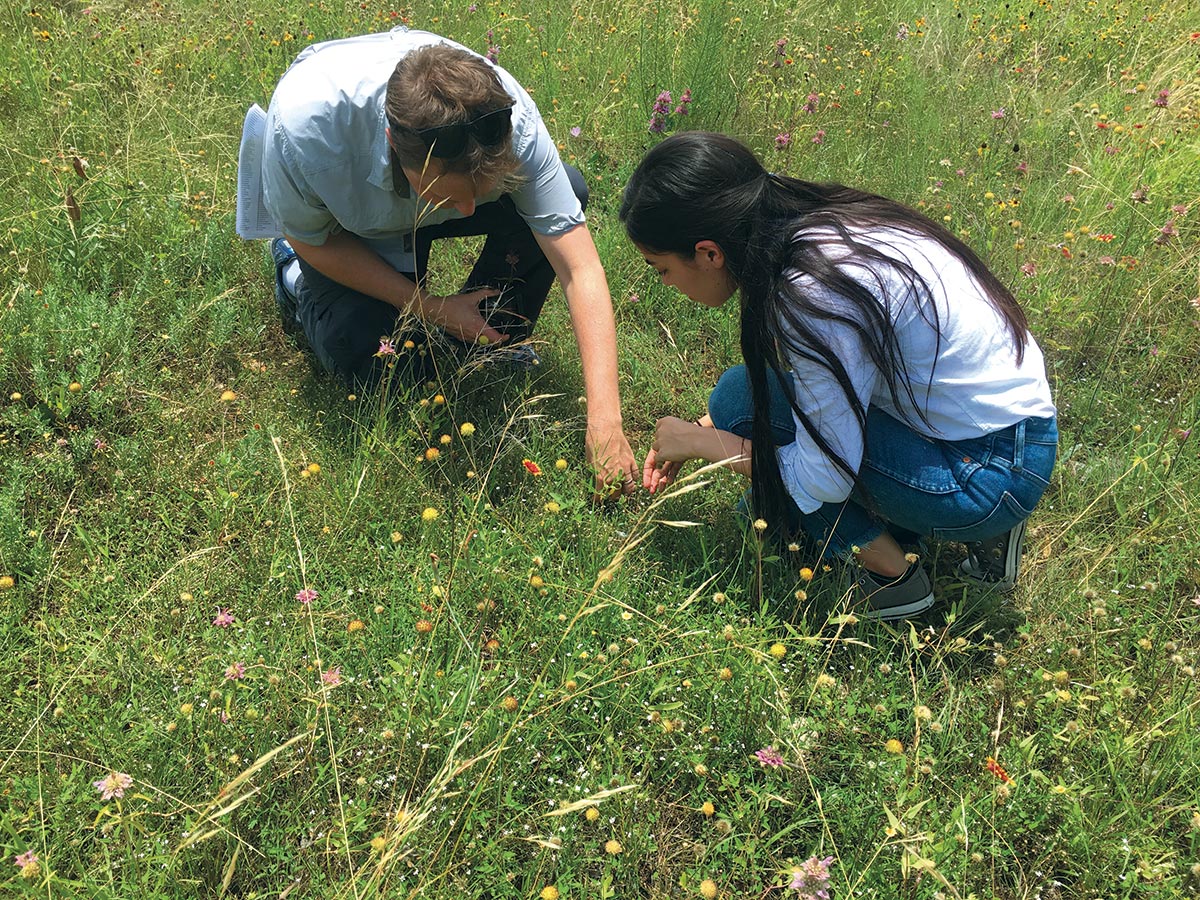Crowdsourcing Conservation

Dr. Morgan Gostel and author Ashley Hackett identify plants for collecting at the Wildflower Center. PHOTO Farahnoz Khojayori
Dr. Morgan Gostel has been passionate about conserving plants his entire life. Now, as a research botanist for the Botanical Research Institute of Texas, he focuses on plant genetics and evolutionary history. He also conducts international outreach efforts as director of the Global Genome Initiative for Gardens. GGI-Gardens was formed in 2015 as part of the Global Genome Initiative, whose mission is to preserve and understand the genomic diversity of life on Earth.
With both a bachelor’s and master’s in biology from Virginia Commonwealth University and a Ph.D. in environmental science and policy from George Mason University, Gostel has spent countless hours growing a strong interest in evolution and plant systematics: the study of biological diversity and the relationships between organisms. Over the course of his academic career, he became especially interested in the evolution of species diversity in dry tropical forests and the plants that inhabit them, which led to fieldwork in the United States, Brazil and Madagascar.
As director of GGI-Gardens, Gostel is establishing an international network of botanic gardens in order to preserve plant diversity. He works with garden partners and teams of interns to collect species of plants that are not represented in biorepositories, or facilities that store plant tissues for future scientific research. The objective is to conserve genetic resources of plant species — a job that, he urges, has to be begin outside, with boots on the ground.
Taking It Outside
Throughout the summer, Gostel — along with Farahnoz Khojayori and Seth Hamby, GGI-Gardens summer research fellows — collected plant species that will go to the Smithsonian National Museum of Natural History. The team traveled to botanic gardens throughout Texas, and their second stop (after Fort Worth Botanic Gardens) was the Wildflower Center. From there, they headed southeast to Peckerwood Garden and Mercer Botanic Gardens and west to Big Bend Ranch State Park and the Davis Mountains Preserve.
“Some of the best places to collect are botanical gardens,” says Gostel. “I don’t think many people realize [these] gardens contain over half of the genera of the plants on Earth.” Some of the species Gostel and his team collected at the Wildflower Center are standing cypress (Ipomopsis rubra), purple coneflower (Echinacea purpurea) and red yucca (Hesperaloe parviflora).

FROM TOP Documenting the collection of standing cypress. Preparing a voucher specimen of Arkansas leastdaisy (Chaetopappa asteroides). Members of the collection team (from left to right): Seth Hamby, Wildflower Center Conservation Program Manager Minnette Marr, Dr. Morgan Gostel, Farahnoz Khojayori. PHOTOS Ashley Hackett
Botanic gardens are important places that showcase plant diversity and allow researchers new opportunities to increase and conserve that biodiversity. Not only do they contain a massive amount of already-named plant species from all over the world, these gardens are usually close to urban centers. That means materials such as liquid nitrogen may be available, as well as a biorepository where genome tissue can be stored. “The materials can be pretty simple or can be complex,” says Gostel.
Deep Freeze
Gostel and his team have been using liquid nitrogen to freeze and store plant DNA. However, the substance is not easy for every garden to obtain. In these cases, a plant press and a bag of silica to preserve DNA tissue works. “If you want high-quality DNA, you want to use a liquid nitrogen tank,” Gostel asserts. “[It] is just the gold standard for plant preservation.”
After freezing the DNA in the liquid nitrogen tank, the team takes another sample of the plant species and records it on a voucher, a pressed plant sample used for future reference. Gostel mentions that collecting a voucher is one of the most important parts of any field work. Without a voucher specimen, it is hard to refer back to and communicate the plant species with other researchers and colleagues.
“We’ve been doing that for 400 years pretty aggressively, as botanists all over the world,” Gostel says. “So explorers who went out and made collections, they did exactly what we’re doing with technology that was perfected years ago.”
After the team completes their plant collection, it will go into the United States National Herbarium (at the Smithsonian). This is where dried plants are stored for biological study, including everything from evolutionary biology to ecology to general floristics, which is the study of plants and where they come from. “People who want to know where they can find something a 100 years later can come here,” says Gostel.
Back to Our Roots
Gostel and GGI-Gardens hope to increase the visibility and impact of botanic gardens for research and conservation of valuable species. To carry out this ambitious goal, they are partnering with botanic gardens, arboreta and greenhouses all over the world to collect and preserve plant diversity.
To Gostel, this partnering is akin to crowdsourcing conservation: It takes advantage of plant collections and knowledgeable staff members at places like the Wildflower Center to make a global impact for plant conservation and plant biodiversity research.
“It’s about getting back to our roots as botanists,” says Gostel, “and going out into the field, exploring and making collections, because we’re losing plants all over the world before we can collect and document them.”
Ashley Hackett is a senior journalism major at The University of Texas at Austin and a former Wildflower Center intern.

